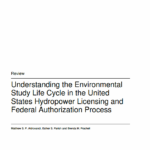Cabin Creek P-2351
General information | |
| Waterway |
South Clear Creek |
| Current status | Active license |
| Type of facility | Pumped Storage |
| Mode of hydropower generation | Peaking |
| Type of permit | FERC License |
FERC information | |
| FERC docket # | P-2351 |
| FERC project name | Cabin Creek Pumped Storage |
| Permit issued | 5/22/14 |
| Permit expiration | 4/26/54 |
Ownership and operation | |
| Owner | Public Service Co of Colorado |
| Owner type | Investor-Owned Utility |
| Year first online (pumped storage) | 1967 |
| Transmission or distribution system owner | Public Service Co of Colorado |
Power and generating capacity | |
| Number of units | 2 |
| Total capacity from pumped storage turbine-generator units | 300.0 MW |
| Pumped storage gross generation in megawatt hours for each powerplant | 218,611.9 MWH |
The Cabin Creek Project is located on Cabin Creek and South Clear Creek in Clear Creek County, Colorado, about 4 miles south of Georgetown, Colorado. The Cabin Creek Project occupies about 326 acres of lands in the Arapaho National Forest managed by the U.S. Forest Service (Forest Service).
The original license for the Cabin Creek Project was issued on March 23, 1964, and the license expired on February 28, 2014. The project was and is operated by the Public Service Company of Colorado, an Xcel Energy Company. The project’s major features include an upper and lower dam and reservoir, a power tunnel, two penstocks, a powerhouse, two step-up transformers, and access roads.
The Cabin Creek Project is operated in a load-following mode that shapes available water to deliver power during peak-load hours with a total plant capability of 336 megawatts (MW) from its two turbines. The average annual generation of the Cabin Creek Project is 172,843 megawatt-hours (MWh).
The upper reservoir is created by a concrete-faced, rock-filled dam with a structural height of 210 feet, and a total length, including the spillways, of 1,458 feet. It has a discharge capacity of 108 cubic feet per second (cfs). Public Service will raise the parapet wall on the upper reservoir dam by 4.5 feet to provide about an additional 75 acre-feet of storage in the upper reservoir, and an additional 93,659 megawatt-hours (MWh) of electricity annually.
The lower dam on South Clear Creek consists of a 1,195-foot-long, 95-foot-high section with two spillways and a combined discharge capacity of about 12,767 cfs. If needed, the auxiliary spillway can pass an additional 10,400 cfs.
The Cabin Creek Project is operated as a daily peaking and emergency reserve facility. When the project is in pumping mode, it can be stopped quickly and reversed to generation mode. When not in a pumping mode, it can be brought on-line within 10 minutes when needed for system generation and stability.
There are no minimum flow requirements in the current license for upper reservoir dam flow releases to Cabin Creek. The current license requires a continuous minimum flow release of 3 cfs or natural inflow, whichever is less, from the lower reservoir to South Clear Creek.
The Forest Service filed a notice of intervention and comments on the application. The U.S. Department of the Interior also filed comments on the application. On March 22, 2013, Public Service filed a settlement agreement signed by Public Service and the Forest Service.
The settlement reached with the Forest Service deals with issues such as fish passages, water quality management plans, and road removal. Other goals of the settlement include maintaining and increasing vegetation near the river, restoring riparian habitats, protecting endangered species, and constructing campsites.
Source: FERC
Is there something you’d like to add or correct? Please let us know.
News and updates
From California Sportfishing Protection Alliance7/17/2024
CSPA Intervenes in Litigation on Drum-Spaulding and Yuba-Bear Hydroelectric Projects
From Hydropower Reform Coalition6/18/2024



